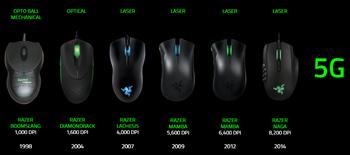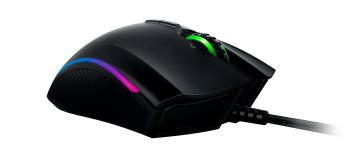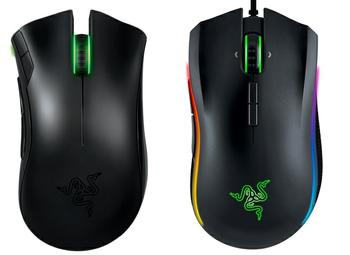Introducing the latest Mamba
The evolution of Razer's gaming mice sensors
Razer's gaming mice are well respected among the PC gaming audience with the DeathAdder, Mamba and Naga among the leading mice in their respective market segments - FPS/MOBA/RTS, wireless and MMO. Razer has maintained these three products for a considerable number of years, choosing to upgrade the designs with new hardware and features as opposed to replacing them outright with different products.
To that end Razer is releasing the latest iteration of the Mamba gaming mouse today, a product that will likely be termed the Razer Mamba 2015 to avoid confusion with earlier revisions. The new Razer Mamba comes in two flavours, the Mamba and the Mamba Tournament Edition. The namesake maintains the hallmark of its predecessor with a latest generation wireless implementation while the Tournament Edition is a permanently wired solution.
Both Mamba variants share the same cutting-edge fifth-generation laser sensor, capable of a mind-boggling 16,000 DPI without the use of interpolation. The sensor is manufactured by Philips and Razer holds an exclusive on its use for a period of 18-24 months. Aside from the staggeringly high DPI, which Razer explains is intended for high resolution displays and multi-monitor setups, the new sensor also supports genuine single-DPI intervals rather than the increments of 50 found on most current gaming mice.
Another advantage of the Philips sensor is the ultra-low lift-off distance of 0.1mm, a 90 per cent reduction over the 1mm implementation on most current Razer gaming mice. The focus isn't all on the sensor, though, since Razer has developed an innovative adjustable click force system which allows the user to choose between 45 and 95 grams of actuation force with 21 equal intervals. Adjustments are made through a provided tool and Razer claims the design is patent pending, though some gamers will be disappointed to know the adjustable click force is reserved only for the wireless Mamba, not the Tournament Edition variant (pictured).
Touching a little more on the wireless implementation Razer proclaims increased battery life for the new Mamba which can now provide 20 hours of operation, that's in contrast to 8 hours on the previous version. The same 1ms 1,000Hz USB polling rate has been maintained using a proprietary 2.4GHz WiFi connection between the Mamba and the charging dock. Razer didn't have specifics for the endurance of the deployed battery but said that battery wear on the Lithium-Polymer solution would be negligible over the product's lifetime.
The latest sensor, wireless design and adjustable click force does come with an eye-watering premium, as you may have anticipated. Razer says that the MSRP for its new mice will be €180/£135 for the Mamba and €100/£80 for the Tournament Edition with availability starting in Q3 for the latter. In for review today we have the Tournament Edition variant since Razer is still fine tuning the adjustable click force system on the wireless Mamba. As a result we expect the Mamba to come to market with a slight delay over its wired counterpart though Razer didn't provide any specifics on availability.
Design
Aesthetically the new Mamba (pictured below, right) is noticeably different to the previous version (below, left) with the relocation of two buttons from the left edge to the centre of the mouse and ridges added along the left and right click buttons based on ergonomic feedback. Another interesting addition is the Chroma RGB lighting which spans the scroll wheel, Razer logo and all around the main body. In total the Mamba has 16 individual LEDs that can be configured using the provided settings in the Synapse software or tweaked in more advanced ways by using the Chroma SDK.
The left side of the mouse holds a duo of thumb buttons which, in addition to the two centre buttons and three-way scroll wheel, gives the user seven programmable options for their macro needs. Both sides of the mouse have a textured rubber coating for increased grip and control while the entirety of the mouse has a soft-touch finish designed to be sweat resistant. The underside of the mouse makes use of three Teflon feet for a smooth glide and the 2.1-metre USB cable is braided for durability.






